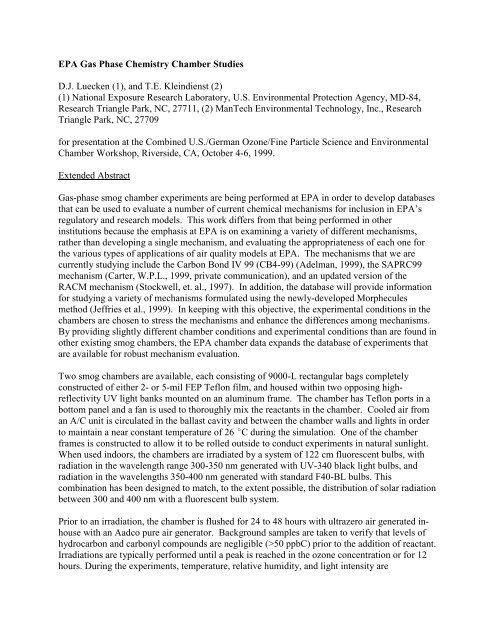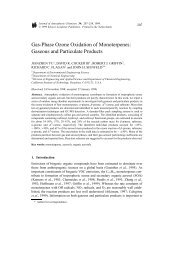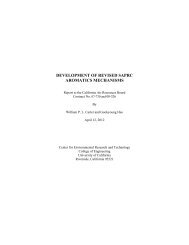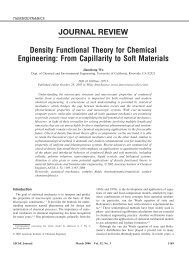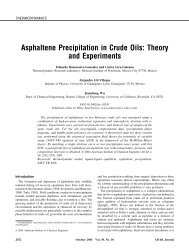View extended abstract in PDF format
View extended abstract in PDF format
View extended abstract in PDF format
Create successful ePaper yourself
Turn your PDF publications into a flip-book with our unique Google optimized e-Paper software.
EPA Gas Phase Chemistry Chamber Studies<br />
D.J. Luecken (1), and T.E. Kle<strong>in</strong>dienst (2)<br />
(1) National Exposure Research Laboratory, U.S. Environmental Protection Agency, MD-84,<br />
Research Triangle Park, NC, 27711, (2) ManTech Environmental Technology, Inc., Research<br />
Triangle Park, NC, 27709<br />
for presentation at the Comb<strong>in</strong>ed U.S./German Ozone/F<strong>in</strong>e Particle Science and Environmental<br />
Chamber Workshop, Riverside, CA, October 4-6, 1999.<br />
Extended Abstract<br />
Gas-phase smog chamber experiments are be<strong>in</strong>g performed at EPA <strong>in</strong> order to develop databases<br />
that can be used to evaluate a number of current chemical mechanisms for <strong>in</strong>clusion <strong>in</strong> EPA’s<br />
regulatory and research models. This work differs from that be<strong>in</strong>g performed <strong>in</strong> other<br />
<strong>in</strong>stitutions because the emphasis at EPA is on exam<strong>in</strong><strong>in</strong>g a variety of different mechanisms,<br />
rather than develop<strong>in</strong>g a s<strong>in</strong>gle mechanism, and evaluat<strong>in</strong>g the appropriateness of each one for<br />
the various types of applications of air quality models at EPA. The mechanisms that we are<br />
currently study<strong>in</strong>g <strong>in</strong>clude the Carbon Bond IV 99 (CB4-99) (Adelman, 1999), the SAPRC99<br />
mechanism (Carter, W.P.L., 1999, private communication), and an updated version of the<br />
RACM mechanism (Stockwell, et. al., 1997). In addition, the database will provide <strong>in</strong><strong>format</strong>ion<br />
for study<strong>in</strong>g a variety of mechanisms formulated us<strong>in</strong>g the newly-developed Morphecules<br />
method (Jeffries et al., 1999). In keep<strong>in</strong>g with this objective, the experimental conditions <strong>in</strong> the<br />
chambers are chosen to stress the mechanisms and enhance the differences among mechanisms.<br />
By provid<strong>in</strong>g slightly different chamber conditions and experimental conditions than are found <strong>in</strong><br />
other exist<strong>in</strong>g smog chambers, the EPA chamber data expands the database of experiments that<br />
are available for robust mechanism evaluation.<br />
Two smog chambers are available, each consist<strong>in</strong>g of 9000-L rectangular bags completely<br />
constructed of either 2- or 5-mil FEP Teflon film, and housed with<strong>in</strong> two oppos<strong>in</strong>g highreflectivity<br />
UV light banks mounted on an alum<strong>in</strong>um frame. The chamber has Teflon ports <strong>in</strong> a<br />
bottom panel and a fan is used to thoroughly mix the reactants <strong>in</strong> the chamber. Cooled air from<br />
an A/C unit is circulated <strong>in</strong> the ballast cavity and between the chamber walls and lights <strong>in</strong> order<br />
to ma<strong>in</strong>ta<strong>in</strong> a near constant temperature of 26 C dur<strong>in</strong>g the simulation. One of the chamber<br />
frames is constructed to allow it to be rolled outside to conduct experiments <strong>in</strong> natural sunlight.<br />
When used <strong>in</strong>doors, the chambers are irradiated by a system of 122 cm fluorescent bulbs, with<br />
radiation <strong>in</strong> the wavelength range 300-350 nm generated with UV-340 black light bulbs, and<br />
radiation <strong>in</strong> the wavelengths 350-400 nm generated with standard F40-BL bulbs. This<br />
comb<strong>in</strong>ation has been designed to match, to the extent possible, the distribution of solar radiation<br />
between 300 and 400 nm with a fluorescent bulb system.<br />
Prior to an irradiation, the chamber is flushed for 24 to 48 hours with ultrazero air generated <strong>in</strong>house<br />
with an Aadco pure air generator. Background samples are taken to verify that levels of<br />
hydrocarbon and carbonyl compounds are negligible (>50 ppbC) prior to the addition of reactant.<br />
Irradiations are typically performed until a peak is reached <strong>in</strong> the ozone concentration or for 12<br />
hours. Dur<strong>in</strong>g the experiments, temperature, relative humidity, and light <strong>in</strong>tensity are
cont<strong>in</strong>uously measured. NO and NO x are cont<strong>in</strong>uously quantified us<strong>in</strong>g a chemilum<strong>in</strong>escent<br />
monitor with a converter that reduces NO x to NO. Because the NO x from this <strong>in</strong>strument is<br />
subject to <strong>in</strong>terferences from PAN and other organic nitrates, it is a good measure of NO+NO 2<br />
only dur<strong>in</strong>g the early stages of photochemical conversion. Ozone is cont<strong>in</strong>uously monitored<br />
dur<strong>in</strong>g the experiment with a chemilum<strong>in</strong>escent monitor. Measurements of organic precursors<br />
and reaction products were identified by us<strong>in</strong>g GC with detection by flame ionization (FID),<br />
electron capture (ECD), or mass spectrometry (MS), with samples taken at 1 to 2 hour <strong>in</strong>tervals,<br />
depend<strong>in</strong>g on the experiment. Peroxyacetyl nitrate (PAN) and other peroxyacyl nitrates were<br />
measured by GC/ECD at 1-hour <strong>in</strong>tervals. Measurements of carbonyl compounds were obta<strong>in</strong>ed<br />
by bubbl<strong>in</strong>g sample air through a solution of 2,4-d<strong>in</strong>itrophenylhydraz<strong>in</strong>e (DNPH) <strong>in</strong> acidified<br />
acetonitrile, produc<strong>in</strong>g carbonyl hydrazones which were separated and quantified by high<br />
performance liquid chromatography (HPLC). Concentrations of nitric acid were obta<strong>in</strong>ed by<br />
sampl<strong>in</strong>g with nylon filters followed by extraction <strong>in</strong> 10 -5 perchloric acid solution and analysis<br />
by ion chromatography. Other <strong>in</strong>strumentation is currently be<strong>in</strong>g evaluated, and alternative<br />
analytical techniques that are be<strong>in</strong>g developed, <strong>in</strong>clude the measurement of organic nitrates by<br />
GC/ECD, determ<strong>in</strong>ation of multifunctional carbonyl compounds with derivatization by<br />
pentafluorobenzylhydroxyl am<strong>in</strong>e (PFBHA) followed by GC/MS analysis, and determ<strong>in</strong>ation of<br />
hydroxylated compounds, <strong>in</strong>clud<strong>in</strong>g organic acids, by derivatization with BSTFA followed by<br />
GC/MS analysis. Exploratory work is be<strong>in</strong>g undertaken to determ<strong>in</strong>e whether new pattern<br />
recognition techniques utiliz<strong>in</strong>g UV absorption spectrometry can be used to measure NO 2 and<br />
HNO 2 directly.<br />
The chamber-dependant reactions are characterized through the use of a limited set of<br />
characterization experiments consist<strong>in</strong>g of s<strong>in</strong>gle component studies of clean air, clean air/NO X ,<br />
CO/NO X , formaldehyde/NOx, and ethylene/NOx experiments. Experiments are performed<br />
under dry conditions and at relative humidities between 50-60%.<br />
Earlier experiments have been performed to study ozone <strong>format</strong>ion potential from a series of<br />
reformulated gasol<strong>in</strong>e and alternative fuel exhaust from new technology vehicles. These<br />
experiments have used authentic exhaust generated from several different vehicles with a<br />
dynamometer and have focused on ozone <strong>format</strong>ion potential as a function of fuel type<br />
(Kle<strong>in</strong>dienst et al., 1994). A set of experimentally-based reactivity parameters were developed<br />
for each fuel. Vehicles run us<strong>in</strong>g reformulated gas (RFG) and ethanol (E85) were found to<br />
produce roughly equal amounts of peak ozone for similar reaction conditions, almost twice as<br />
much as methanol-fueled (M85) vehicles, and over 4 times as much as vehicles run us<strong>in</strong>g<br />
compressed natural gas (CNG). (Measurements were made for standard VOC/NO X ratios of 5.5)<br />
Another result of this work has been the creation of auto exhaust surrogates that were prepared as<br />
tank mixtures us<strong>in</strong>g whole fuel with a dozen additional components represent<strong>in</strong>g the major<br />
combustion-derived components. These surrogates have been shown to reliably reproduce ozone<br />
<strong>format</strong>ion and other photochemical constituents and reactivity parameters compared to direct<br />
automobile exhaust.<br />
Studies of branched and straight cha<strong>in</strong> C 5 -C 8 alkane reactions have been performed <strong>in</strong> the<br />
chamber. Although these compounds are not extremely fast react<strong>in</strong>g, they are emitted <strong>in</strong>to the<br />
atmosphere <strong>in</strong> large quantities from automobile exhaust. For these studies we have comb<strong>in</strong>ed<br />
dynamic and static chamber simulations to better identify and quantify multifunctional
oxygenated compounds, organic nitrate, and secondary product <strong>format</strong>ion. The static smog<br />
chamber was used to provide moderate conversion of reactants to products without major<br />
<strong>in</strong>fluences due to sampl<strong>in</strong>g and dilution, allow<strong>in</strong>g quantitative determ<strong>in</strong>ation of the reactive<br />
hydrocarbon loss and of the product <strong>format</strong>ion rates. Simulations were also done us<strong>in</strong>g a<br />
dynamic reactor consist<strong>in</strong>g of a 1-L Pyrex bulb reaction vessel, which had been deactivated with<br />
dichlorodimethylsilane, and irradiated by F40-BL fluorescent bulbs. The dynamic simulations<br />
allowed complex organic compounds to be more easily observed and quantified by vary<strong>in</strong>g the<br />
extent of the reaction.<br />
This year’s experiments focus on study<strong>in</strong>g complex mixtures of hydrocarbons, <strong>in</strong>clud<strong>in</strong>g both<br />
branched and straight cha<strong>in</strong> members of each class <strong>in</strong> comb<strong>in</strong>ations similar to those found <strong>in</strong><br />
rural and urban atmospheres. These mixtures are designed to test the effect of the hydrocarbon<br />
lump<strong>in</strong>g schemes used <strong>in</strong> current chemical mechanisms versus the more explicit Morpheculetype<br />
approaches. We are also coord<strong>in</strong>at<strong>in</strong>g gas-phase smog chamber experiments with studies of<br />
aromatic and biogenic hydrocarbons performed <strong>in</strong> the PM chemistry program, by perform<strong>in</strong>g<br />
gas-phase only experiments for compounds which are also studied <strong>in</strong> the particle chamber.<br />
Future plans <strong>in</strong>clude us<strong>in</strong>g enhanced analysis techniques to more completely characterize NO y<br />
and product <strong>format</strong>ion. We are establish<strong>in</strong>g a protocol for the types of comparisons that must be<br />
done to thoroughly compare chemical mechanisms, us<strong>in</strong>g a Process Analysis approach. In<br />
conjunction with our model<strong>in</strong>g of the smog chamber data and comparison of results us<strong>in</strong>g<br />
different mechanisms, we hope to provide support for the clarification of uncerta<strong>in</strong> reaction<br />
parameters <strong>in</strong> atmospheric chemical mechanisms.<br />
References:<br />
Adelman, Z.E., A Reevaluation of the Carbon Bond-IV Photochemical Mechanism, PhD thesis,<br />
University of North Carol<strong>in</strong>a, Chapel Hill, NC, 1999.<br />
Jeffries, H., and Kessler, M., Morphecule/Allomorph Reaction Mechanisms, F<strong>in</strong>al report to U.S.<br />
EPA, contract 68D50129, 1999.<br />
Kle<strong>in</strong>dienst, T.E., Liu, F., Corse, E.W., and Bufal<strong>in</strong>i, J.J. “Development of a chamber system for<br />
determ<strong>in</strong><strong>in</strong>g measures of reactivity from exhaust of alternative-fueled vehicles”. SAE No.<br />
941906, Society of Automotive Eng<strong>in</strong>eers, Warrendale, PA, 1994.<br />
Stockwell, W.R., Kirchner, F., and Kuhn, M. “A new mechanism for regional atmospheric<br />
chemistry model<strong>in</strong>g”, J. Geophys. Res., 102(D22): 25847-25879, 1997.<br />
-------------------------<br />
This work has been funded <strong>in</strong> part by the United States Environmental Protection Agency under<br />
68-D5-0049 with ManTech Environmental Technology, Inc. It has been subjected to Agency<br />
review and approved for clearance.


